After replacing the Curtis 1231C-8601 motor controller that had failed, I opened the case up to figure out what had failed. The controller hardware is inside of an aluminum extrusion with both ends “potted” with some black semi-flexible material (hard silicon perhaps?) that could be cut using a razor knife and a lot of effort.
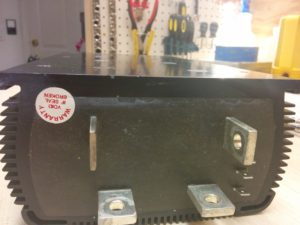
Inside, there is a Pi shaped piece of aluminum extrusion that acts as the heatsink for the MOSFETS and freewheeling diodes, as well as being electrically connected to the motor – terminal. It is held against a large thermally conductive, but electrically insulating pad, which separates it from the controller case, but allows heat to be dissipated. It is held in place with 8 screws that pass through insulating plastic brackets into the bottom of the case.
People online had told me that these screw holes were “potted”, but on my controller they were just filled with two rubber plugs.They also told me that you could not cut through the Curtis potting material with a razor knife. [This super hard potting material was also prone to cracking at the edges and letting moisture into the controller, so a flexible rubber like material is better anyways…]
So either my controller had already been opened up, or Curtis had decided to use rubber plugs for the holes and a more flexible potting material on the controller that I had. (There was a “Warranty void if seal broken” sticker on the front, and as far as I could tell the inside of the controller was completely stock, so I’m leading towards Curtis just using a different potting material, but it’s possible somebody may have already repaired it once using exact replacement parts and put their own warranty sticker on it. There were some markings inside that might be from the factory, or might be from a repair shop you’ll see photos of farther down.)
I removed all 8 screws and plastic bushings from the bottom, and then cut around the potting material “end-piece” on the front (terminal) side and pulled the entire controller unit out of the aluminum extrusion case. Then I had to cut around the terminals and pulled the potting material off the front. It had some type of fiberglass panel between the potting material and the piece of black foam behind it. I was not able to remove the potting material and fiberglass panel in one piece, so if/when I put it back together I’ll just have to re-pot it with black silicon.
Once the guts were removed, I could see a spot under the control board where some power electronics had fried. [The common failure mode for these controllers is for the MOSFETS nearest to the logic control board to blow up, because they turn on just slightly sooner than the other MOSFETS due to the propagation delay of electricity through a wire.]
I had to unsolder the 7 connections between the logic board and the power board (as well as a 2 wire thermocouple) so that I could remove the logic board and see the blown power electronics. The immediate problem was not hard to spot…
Curtis 1231c-8601 power board components
The Curtis 1231c-8601 power board is relatively simple. It uses 18 MOSFETS in parallel to switch current from the motor- terminal back to the battery- terminal (the motor+ lead is already connected to battery+). The MOSFETs it uses are IXYS IXTH50N20 SP9536 chips. The center lead is bent up over the chip and soldered to a ring terminal, such that the screw that attaches the chip to the heat sink also electrically connects that pin to the heat sink. Most chips that attach to a heatsink have a metal back, but the IXTH50N20’s used here do not, so it appears that they had to take extra assembly steps to electrically couple it to the heatsink. The power MOSFETs have a 47 ohm resistor on their gate drive line. Such a high value was chosen to deliberately slow down the switching of the MOSFETS, so that the ones nearest to the logic circuit would not be able to turn all the way on before the ones farther away had a chance to shoulder some of the load. It would appear that this strategy was not entirely successful, as the closest MOSFETs blowing up is a common failure mode.
Near each MOSFET is a freewheeling diode (used to conduct current between the motors +/- terminals when the MOSFETS are not conducting current from the battery. They are TSR2402R 7103 K units, which basically have two sheets of metal with a round diode mounted between them. They are “reverse polarity” Schottky diodes, which means that the anode is connected to the heatsink by the screw (as well as being connected to the power PCB by a lead. Unfortunately, they are difficult to source replacements for in this form factor. Fortunately, they usually do not blow up like the MOSFETS.
Here is a bottom view of one of the failed MOSFETs:
One leg was completely melted. The arcing electricity actually ate some of the metal case of the diodes that were mounted next to the MOSFETS! (amazingly, these diodes appear to be still working.)
In addition to the obvious damage to two of the MOSFETs, I noticed a third mosfet that has some residue around it. Although not as obviously blown apart, this guy may have issues as well. In general, when one MOSFET in the set blows up, you should replace them all, as others may have been overstressed and ready to fail.
Also, a trace on the logic board has been blown away. If you look at the four wire connector just to the left and above the white “ORB-102 w/o 60355 rev.M” sticker, you will see that the second pin from the right leads to a trace that has acted like a fuse. Arcing electricity probably got it. There were also a few traces on the power board that will need to be fixed.
Here are a few shots of the Pi shaped heatsink showing where all the MOSFETS and diodes were attached on one side and the soot pattern.
I should also mention that the 1231c has the option to “plug brake” (more for forklift operation than on-road vehicle usage) and has six plug braking diodes connected to an A2 terminal that is unused in my application. I just unscrewed the entire connector assembly and A2 terminal, and will probably not bother re-installing it as I don’t need it.
I found a few hand markings inside the terminal. One was the “OV 174” pictured above, and the other was this “CIL / M1” on the cardboard shield that fit between the power electronics and the logic board.
In addition to the MOSFETS and Diodes, the power board also has 35 capacitors used to reduce ripple as the MOSFETs switch. They are Nichicon 220 uf 200v electrolytic capacitors.
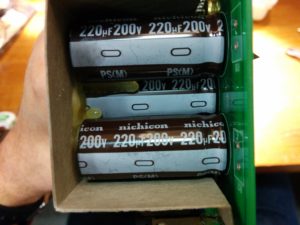
There was also one other component attached to the heatsink (but electrically isolated with a silicon pad). it was a Vishay IRFP254 532P power MOSFET at location Q13.
This MOSFET is used as a 24 volt voltage regulator to power the logic part of the circuit
Here is a video of the procedure:
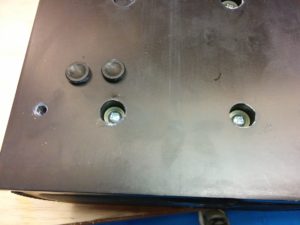
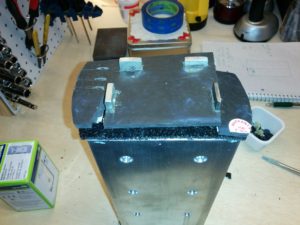
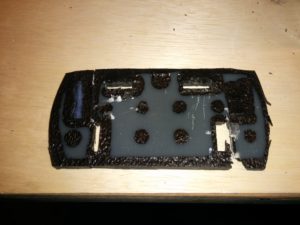
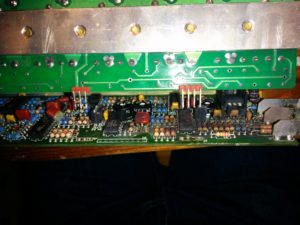
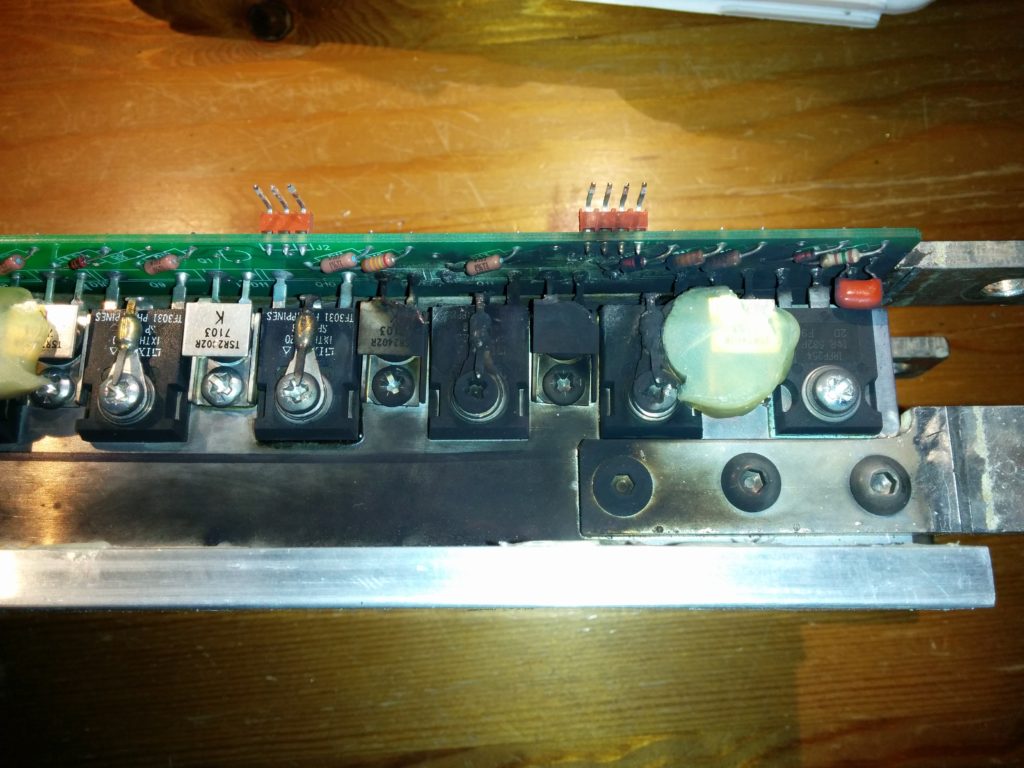
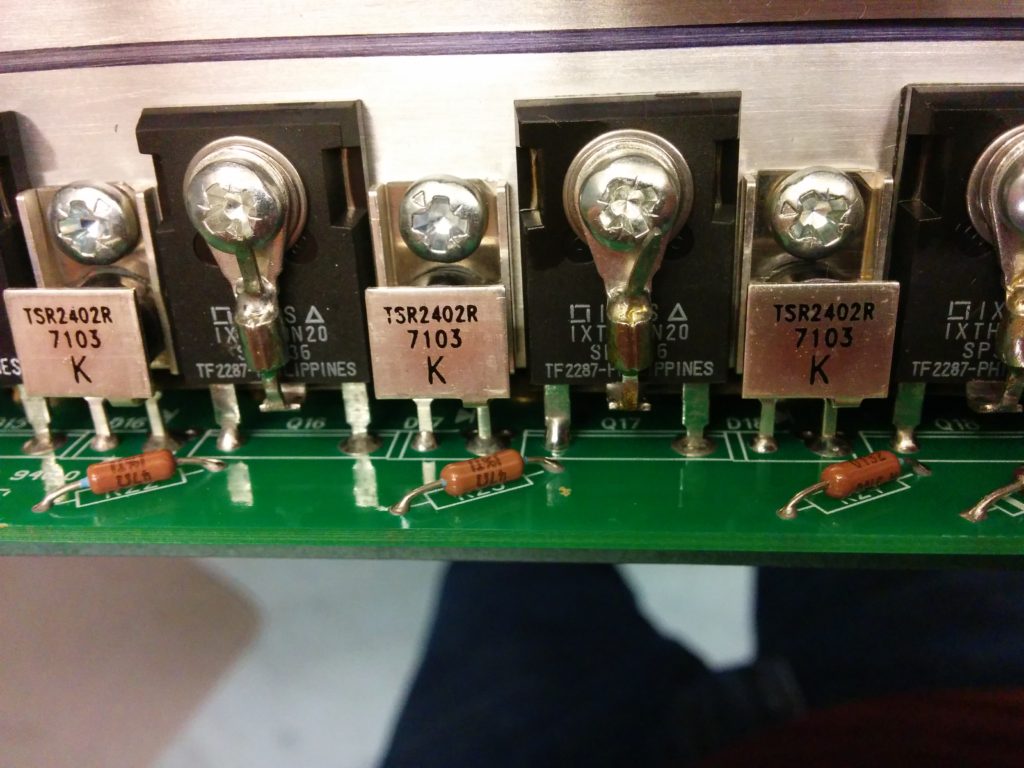
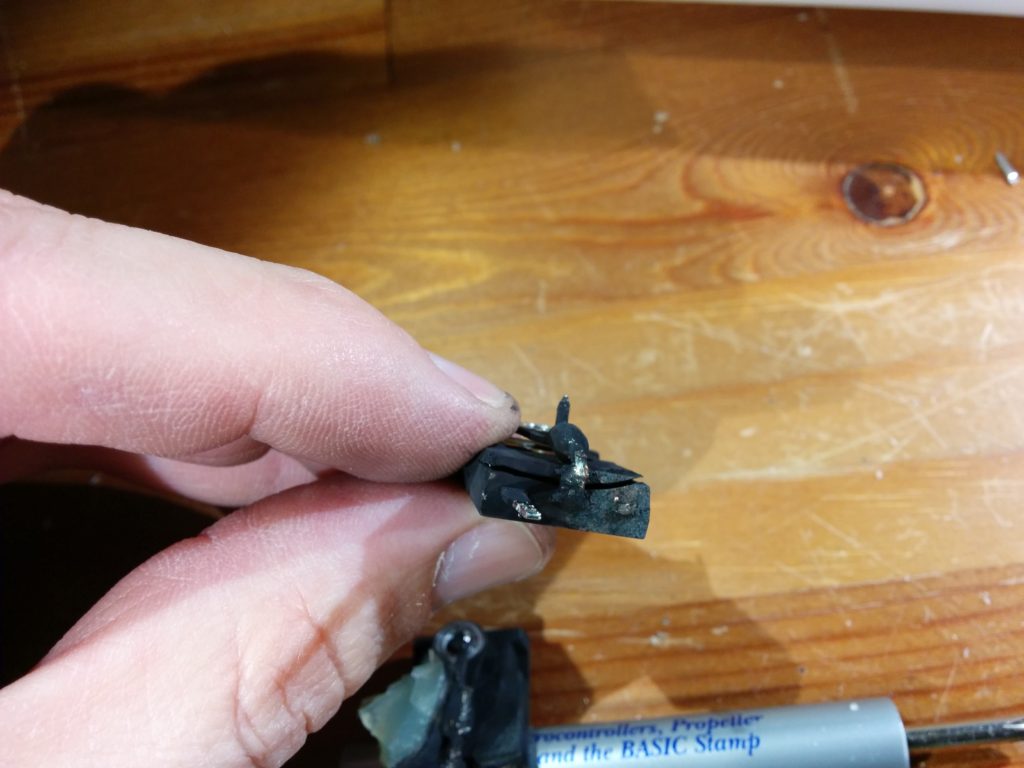
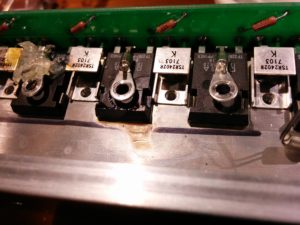
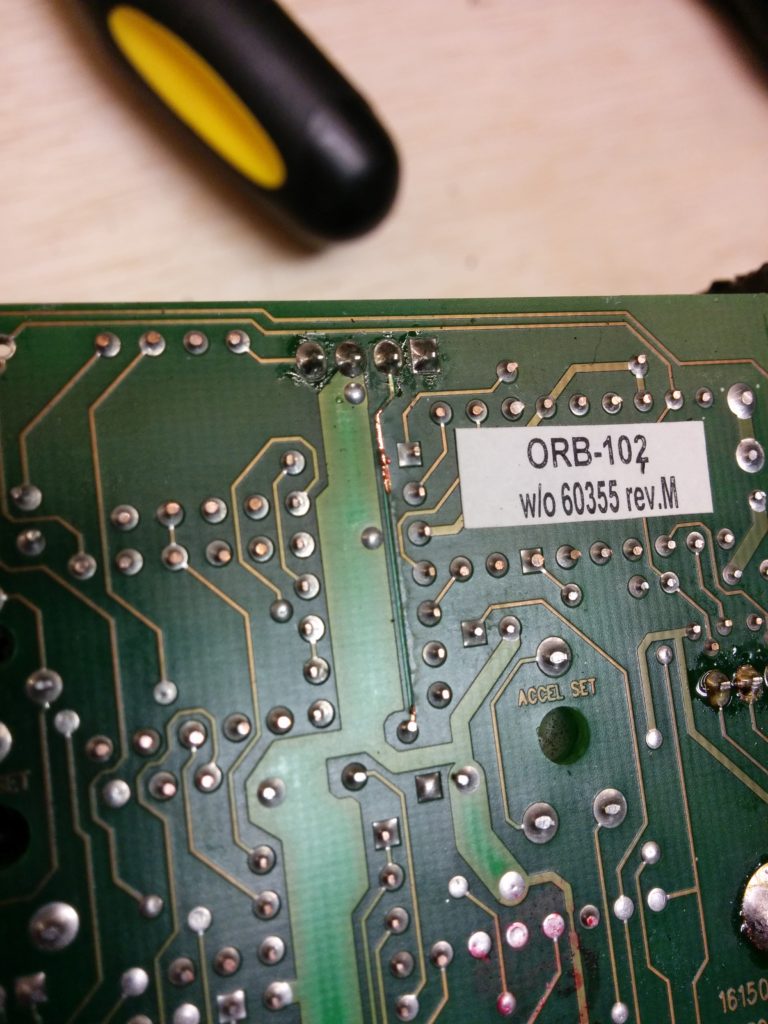
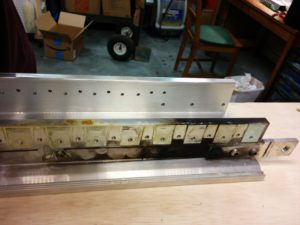
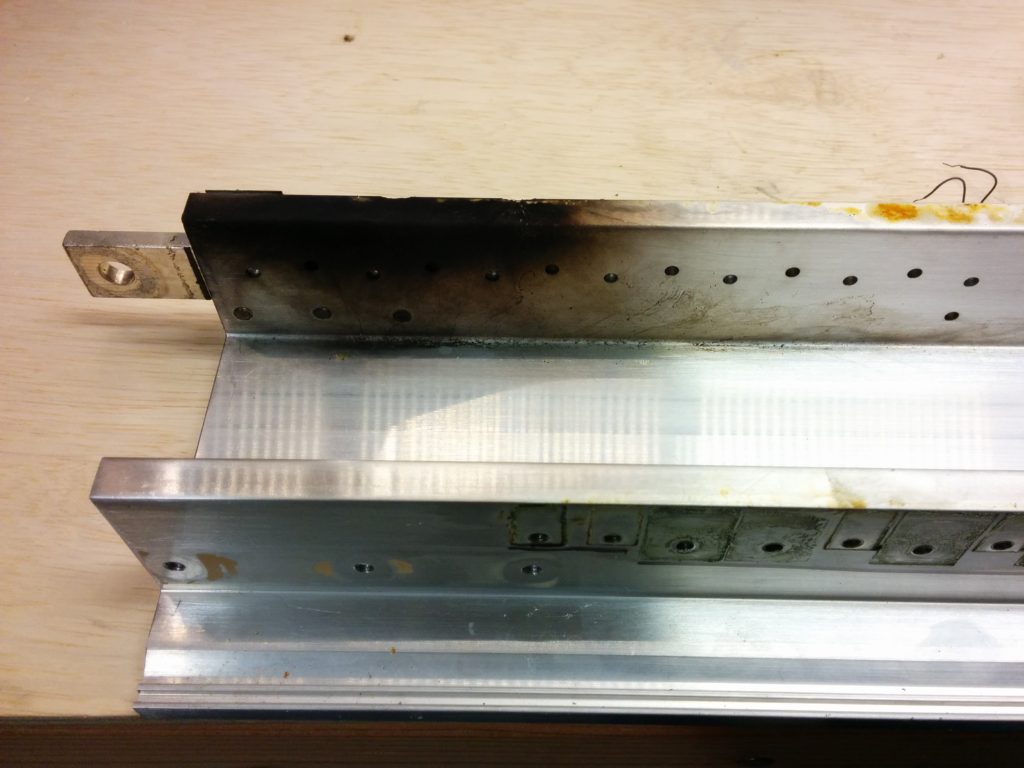
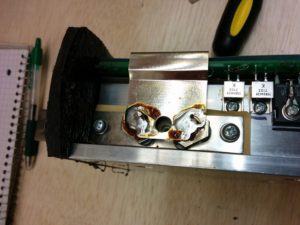
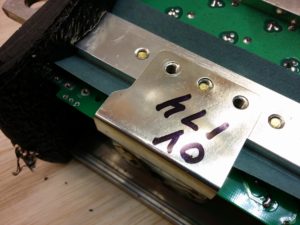
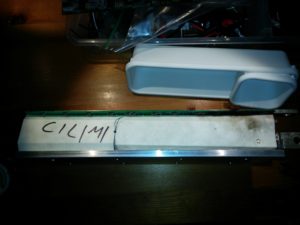
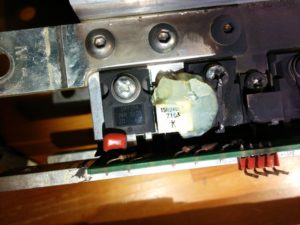


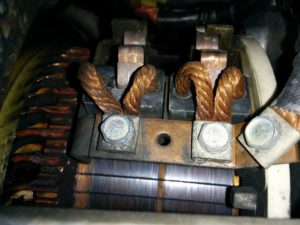
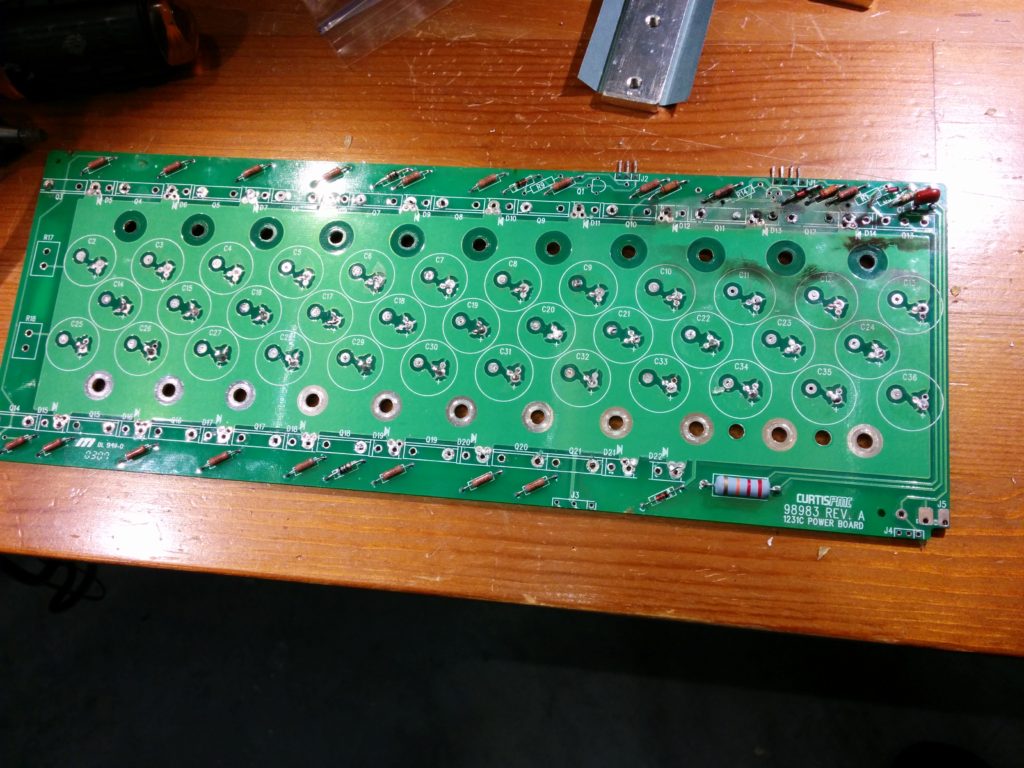
Quit often the mosfets blow up randomly the 47 ohm resistors are to lower emi and try to get all of the fets to work together please check the two 18 volt zener diodes the odd fet is the 24 volt series regulator with it damaged the 27 volt zener is probably bad as well with the blown trace on the control board open the 14 volt series regulator on the smaller heat sink may be bad as well Q4 and Q5 may be bad as well. About the construction older units had epoxy filled holes the newer units have the plugs I have yet to see a C version with epoxy plugs and I have worked on over 100 model 1231 and 1221
I have replacement boards for the 1231 and the control boards the Q13 fet is a linear rated part all the rest are switching rated parts
Thanks, I’ll be in touch if I can’t repair the traces with some wire…
Anybody here know the overvoltage cutoff for 1221c (120v nominal) and 1231c (144v nominal) ?? I’m wanting to use Lithium modules that result in a full charge at ~149v or 198v… and wondering if these controllers can take it. … thanks.
The curtis controllers were designed with lead acid batteries in mind, so a 120 volt pack would get up to 130 or maybe 132 when fully charged. Note that my truck had a 120 volt pack, but uses the 1231c with a 144v maximum rating, so it is well within it’s design specifications as the maximum voltage is around 131 volts.
I expect the 96-144v controller would work a 149v max pack, but I wouldn’t go with a 198 volt pack and a curtis controller.
The mosfets and capacitors inside are rated at 200v absolute maximum.
Sir, I need to know if you can help me to discover the value of each of the burnt resistances of my curtis 1244. If so, you can send me an email where I can send you some pictures of the plaque. Thank you.
I am sorry, I do not have any information about Curtis inverters other than the 1231c model.
Jay
I have a 1231C-8601 that I am (was!) using in my VW Cabbie. I have 18 6-v GC batteries. After about ten years it failed in the FULL ON mode.
Is it worth considering a repair?
Well, I bet that was an exciting failure……I doubt it is worth repairing.